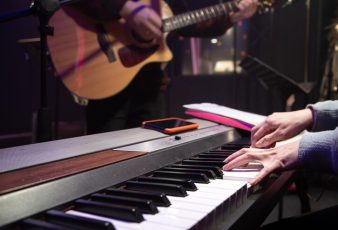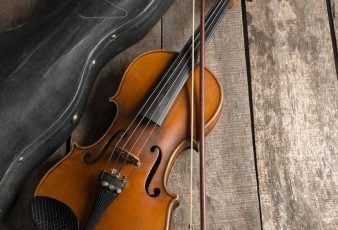Many parents who realize that their children are musically inclined often overthink about what instrument to introduce first. If you’re reading this, you’re likely one of those mommies or daddies concerned about picking the right musical instrument for your child.
Because of their imaginative nature, your child is highly likely to develop a liking for music and even develop a passion for it quickly. Besides serving as a fun pastime, studies show that playing an instrument also improves children’s physical skills, boosts academic performance, and helps them develop healthy social skills.
Mastering an instrument entails regular and frequent practice. So, in order to give your child a better chance at mastery while ensuring that they have a more enjoyable time, help them pick out an instrument that’s suitable for their musical inclination.
But how can you do that? Consider the following five tips:
How to Help Your Child Pick Their First Musical Instrument: 5 Tips
1. Your child’s age
Although some children are prodigies in certain instruments, you need to consider your child’s age when suggesting instruments that they can learn.
Kids six years or older have a wide range of choices of musical instruments, but those younger may be limited to certain instruments that they can handle based on their physical capacity.
If your child is in the latter group, two of the best choices you have are the piano and the violin.
With the violin, you can buy a smaller-sized instrument according to your child’s size. It can also help your child learn how to tune an instrument easier, something that they will need to develop their musical skills.
On the other hand, the piano is an excellent instrument for teaching foundational music skills. Although they absorb information better, younger children need a visual representation to get a good grasp of musical theory, and a piano can give them that.
Many of the best preschools in Singapore offer music lessons to kids. This helps them take an interest in a musical instrument of their choice early on in life. Starting early also allows them to pick up music lessons as the mind at that stage is quite active and can pick up things pretty fast.
2. Your child’s physique
While most parents generally don’t like to limit their children’s choices, your child’s physical limitations might leave you with no choice but to think otherwise.
As mentioned earlier, age can come with physical limits that include your child’s body size and strength. And both are crucial in choosing the perfect first instrument for your child.
While it’s true that music is easily learned at a younger age, some instruments are easier to handle than others based on a child’s capacity to hold it in place or reach certain parts of it relative to his height.
Height:
Certain instruments can be tough to play without the full range of motion required. For example, a child needs to be tall enough to use a trombone’s slide mechanism to its full capacity as being shorter than what’s necessary may limit their range of motion.
Fortunately, most instruments come in a variety of sizes, which means you can buy your child one that’s more appropriate to their height. Still, this means you’ll need to invest in new versions of the instrument as your child grows taller to accommodate their physical development.
Physical Strength:
Some instruments tend to be heavy and bulky, like the cello or the tuba. This means that your child must be strong enough not only to hold and play but also to carry the instrument from one place to another.
Also, you need to consider your child’s back and core strength to maintain proper posture. For instance, drummers need to have a good posture if they are to avoid shoulder, neck, and back injuries after performances.
So, while a full set of drums can be learned as early as age six, it may be best to introduce your child first to an electronic drum set that is less bulky than a traditional drum set.
Aside from these two physical factors, there are also certain instruments that require specific physical attributes to be played properly, such as:
- Tuba – This woodwind instrument is best for students with larger lips.
- Piano – Although the piano is deemed one of the easiest instruments for younger children to learn, some musical trainers still think those with large hands or long fingers have an advantage as these attributes provide the level of dexterity required to play the instrument
- Trombone – Ideally, a trombone player must have even teeth as an overbite, under-bite, or even the presence of orthodontic braces can impede the player from performing well.
3. Your child’s personality
Besides your child’s body type, you also need to consider their personality when offering suggestions for their first instrument.
For example, if your child prefers to be the center of attention, you might want to steer them toward the flute. Since flutists usually stand in a band, kids who are always happy, smile a lot, and are talkative are a great fit for this instrument.
Moreover, extroverted children who like to be the star of the show are suited to learn the electric guitar and violin — both of which are commonly featured as prominent parts of musical groups.
Meanwhile, kids with a propensity for analysis or who are inquisitive tend to do well with the piano. The instrument is also quite popular among more reserved children, as it is usually learned and performed in smaller groups or solo.
Those with above-average intelligence also tend to perform well with an oboe, which is considered a very intricate musical instrument.
4. Your child’s interests
Perhaps the most important thing you must consider when choosing an instrument to offer your child is their interests. After all, how can they be passionate about learning music if they don’t like the instrument they are playing.
Remember that forcing an instrument on a child may cause them to lose interest in it quickly, especially if they prefer a different one. The key to learning which instruments tickle your child’s fancy is to determine what sounds they appreciate.
You should also take them with you when shopping for an instrument so they can experience them first-hand before you purchase any. This can also help you see their affinity for harmony (violin), melody (lead guitar), or rhythm (drums).
5. Be practical
Finally, your considerations should include practicality. Think about whether your child could and would use the instrument regularly. Remember that kids need to use an instrument for 20 to 30 minutes every day to improve in playing it.
It is, therefore, crucial that you choose an instrument that your child can practice at home or in school regularly.
For instance, drums and pianos may be too bulky to keep at home and may not always be available at school. On the other hand, high-quality stringed instruments like guitars and violins, as well as woodwinds like the flute and clarinet, have the advantage of portability and ease of access.
The Takeaway
Offering your child an instrument should always be based on them — their age, body type, strengths, and interests.
Follow the tips listed in this article so you can assist your child on their musical journey.
Read Also:





























